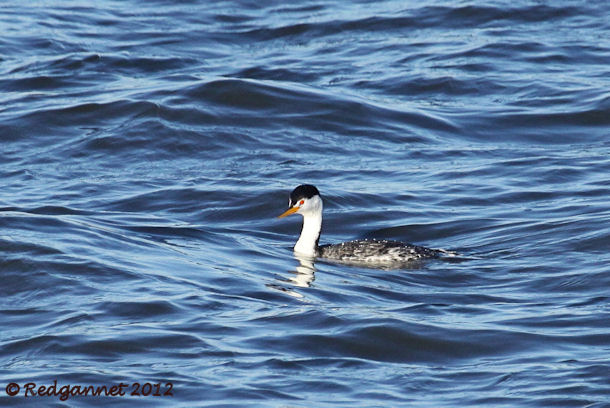I had ridden the train one hour south
from San Francisco to reach the Baylands Preserve at Palo Alto. After spending
the morning around the Duck Pond and Lucy Evans’ Interpretative Centre, I moved
on to Mayfield Slough and Charleston Slough for the afternoon.
From the junction just beyond the airport on Embarcadero Road (at Google Earth
ref; 37°27'13.73"N 122°
6'35.56"W), turn right (south) instead of left and follow the road around.
Many of the birds seen in the morning
were ticked again, but a few extra species that were missed in the morning were
added. American Wigeon was the first
bird seen in the reeds across the channel opposite the junction. Green Teal, Mallard and of course Northern
Shoveler (the most populous bird of the day by far) were also seen here.
The channel on the left is affected
by the tides of the bay and the water had just reached its highest mark for the
day. On the right is Mayfield Slough which is controlled with a sluice, but (I
think) is also subjected to tidal movement. Good numbers of Canvasback and a Western Grebe were seen on the slough.
Just before the bridge, I saw a White-tailed Kite hovering above the
point. It made a swooping attempt to catch a meal but missed and glided away as
I approached.
An island on Mayfield Slough made a
popular roosting spot for a flock of Willet
with a few Marbled Godwit mixed in, until
a Northern Harrier flushed them up. A number of gulls just beyond them did not trouble
the eBirder in me, but they can still be seen on Google Earth if you cut and
paste these coordinates; 37°26'56.11"N
122° 5'31.63"W.
Suddenly I was enveloped in a storm
of tiny wings and rushing wind as a large flock of “peeps” crossed the track. I
didn’t see what had flushed them, but they were reluctant to settle.
Eventually, they landed further across Mayfield Slough, but were still nervous
and restless. They flushed two or three times as I watched. I had assumed them
to probably be Western or maybe Least Sandpipers, they appeared to be
the right size, but my experience with large flocks of them is limited. Do they
form tight flocks, banking and turning in much the same way that Dunlin do?
A short way further down the slough I found that they do mix in with each other.
A short way further down the slough I found that they do mix in with each other.
On the left of the path is Charleston
Slough. Canvasbacks added to their already impressive number here. By contrast,
a pair of Gadwall were the only ones seen today. A small island was thick with
roosting birds. Most of them were Marbled Godwits, but there were also
Black-necked Stilt, Willet and the seemingly ubiquitous Shoveler.
The biggest concentration of birds
was seen in the seep pond at Google Earth ref; 37°26'5.73"N 122° 5'56.71"W.
Long-billed Dowitchers, American Avocets and mixed gulls were roosting here with species flocked together according to their feather.
Long-billed Dowitchers, American Avocets and mixed gulls were roosting here with species flocked together according to their feather.
A couple stopped to pass the time of day and asked me
why the birds were so chatty. The Long-billed Dowitchers are known for their
habit of chattering as they feed. It seems that they keep it up while roosting
too.
At the edges of the flocks a few other species found room to roost and feed, possibly gaining some comfort from the hundreds of pairs of eyes keeping lookout for them.
At the edges of the flocks a few other species found room to roost and feed, possibly gaining some comfort from the hundreds of pairs of eyes keeping lookout for them.
The way home took me along the
Bayside Trail parallel to Shoreline Drive. A flock of Surf Scoter were seen
alongside the Ruddy Duck out on the water with Lesser Scaup and a Clarke’s Grebe
closer in.
A Red-tailed Hawk landed on a street
lamp as I passed and posed very nicely.
The Burrowing Owls continue to elude
me here, but a Barn Owl made up for it as I worked my way back to the Caltrain
station.
Birds seen; 37
Canada Goose 15, Gadwall 2, American
Wigeon 90, Mallard 40, Northern Shoveler 950, Green-winged Teal 25, Canvasback
610, Greater Scaup 10, Lesser Scaup 2, Surf Scoter 60, Common Golden-eye 5, Ruddy
Duck 220, Pied-billed Grebe 1, Eared Grebe 2, Western Grebe 1, Clarke’s Grebe
1, Double-crested Cormorant 3, Brown Pelican 1, Great Blue Heron 1, Great Egret
2, Snowy Egret 9, Black-crowned Night Heron 1, White-tailed Kite 1, Northern
Harrier 1, Red-tailed Hawk 1, American Coot 400, Black-necked Stilt 30,
American Avocet 400, Willet 250, Marbled Godwit 210, Western Sandpiper 15,
Dunlin 8, Long-billed Dowitcher 700, Barn Owl 1, Western Scrub-jay 2, Western
Meadowlark 1, House Finch 45.
12 extra species were seen this
afternoon bringing the day’s tally to 67.
There are a couple of options to
reach the Caltrain station for return to San Francisco. From the seep pond at
Terminal Blvd, follow San Antonio Rd south for 2 miles to the San Antonio
Station at Google Earth ref; 37°24'24.41"N 122° 6'22.18"W.
From the barrier across N Shoreline
Blvd at Google Earth ref; 37°25'43.07"N 122° 4'41.35"W, continue
south for 1.8 miles. Turn left opposite Jack in a Box onto Stierlin Rd.
Mountain View Station Google Earth ref; 37°23'42.09"N 122° 4'39.81"W is a further half
mile.
For previous posts from Palo Alto Baylands, follow the links below;
Visit the dedicated USA and CanadaPage for more posts from the area.













No comments:
Post a Comment